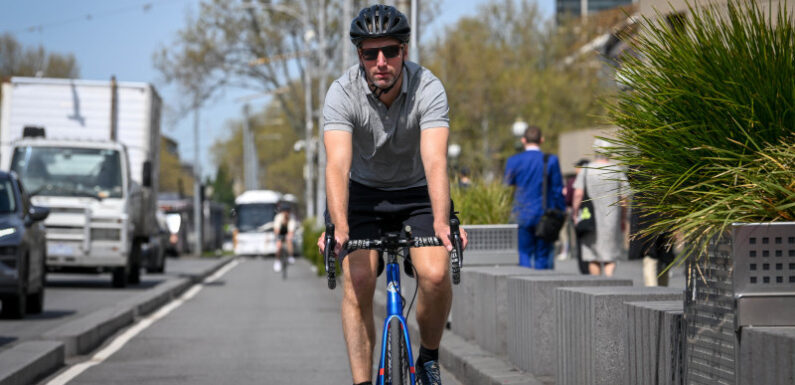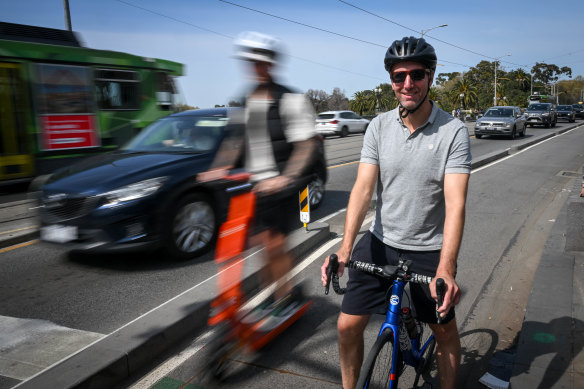
Save articles for later
Add articles to your saved list and come back to them any time.
Professor Marco te Brömmelstroet scoffs at Melbourne’s frequent ranking as one of the top three most-liveable cities in the world.
“I find it quite amazing,” he says. “Somehow they are not measuring the quality of your streets.”
Self-described “professor of cycling” Marco te Brömmelstroet says riding in Melbourne is for “high-skill risk-seekers”.Credit: Eddie Jim
The chair of Urban Mobility Futures at the University of Amsterdam – located in arguably the most cycling-friendly city on Earth, where about one-third of all journeys are by bike –calls himself the “cycling professor”.
He’s on a mission to spread Dutch bicycle know-how around the world – and he’s not impressed.
Brömmelstroet, who took The Age on a leisurely ride from St Kilda Pier to Princes Bridge, along a scenic route of off-street bike paths, says that in most of the city, cycling is only for “high-skill risk-seekers”.
“The 99 per cent of people who would like to bike but are too concerned and not willing to face those risks – they have no options,” he says.
The Andrews government wants to grow cycling and walking for transport from 18 per cent of all trips to 25 per cent by 2030 as part of its climate change pledges. Even the RACV wants more people to ride instead of drive to ease road congestion.
But the roll-out of bicycle lanes to make that possible has been met with fierce backlash from some residents and traders about the loss of road and parking space for cars. VicRoads ripped up 40 kilometres of new lanes in City of Port Phillip this year and the City of Melbourne paused its CBD lane roll out in 2022.
Brömmelstroet says these efforts will keep failing as long as governments and councils talk about “infrastructure, transport and mobility”.
What’s more important, he says, is a conversation about the cost of cars dominating our city, for the environment, for society and – especially – for children.
“Children have been losing a lot of their rights: the rights to public space, the right to roam, the right to be autonomous, the right to claim the city,” he says.
Brömmelstroet says every child should have the freedom to travel to school by themselves. In the Netherlands, three-quarters of high school students walk or ride. Studies show they are also the happiest in the world.
In Melbourne, just 20 per cent walk or ride – and that’s down from about 33 per cent over the past 50 years. The number of children being driven to school has jumped from 20 per cent to 64 per cent, government data shows.
Brömmelstroet says there is growing concern that something is going “terribly wrong” with young people’s mental health and believes that designing cities to encourage connection to other people is part of the solution.
As he rode, he gestured towards a seven lane road – five of traffic, two of parking – separating Middle Park Beach from the bayside neighbourhoods.
“This is designed for disconnection,” he says. “Individuals going from A to B in a cocoon.”
When he meets Victorian government officials during his visit to Melbourne, the Dutch academic will point to Paris to show what is possible.
The city of love’s mayor, Anne Hidalgo, was re-elected with a sweeping policy to remove almost half the city’s on-street car parks – about 70,000 – while banning cars from school streets and building hundreds of kilometres of new bike lanes.
“She’s doing that as part of a bigger narrative of a city that needs to repair and reconnect. And that story was so convincing that she got the majority of votes,” Brömmelstroet says.
“If you have an alternative narrative, you have much more support than you think. But if you keep talking about it in these narrow terms of, ‘I will take your space, and we’ll give it to somebody else’, you will create backlash.”
“You will keep poking at the privilege of a few, and they will get angry. But now, the people who are losing out – the children – they’re angry but we don’t hear them.”
Melbourne, with its sprawling suburbs and growing network of highways, is not Amsterdam or any European city, and opponents of bike lanes say we shouldn’t pretend that it is.
But Brömmelstroet argues that cities are shaped by small choices made over decades. Amsterdam was choked with cars until mass protests in the 1970s against their dominance and vehicular “Kindermoord” (child murder) forced that to change.
“We’ve taken for granted that our cities look the way that they do, but should realise they’ve been recently developed to become how they are today, which means we have the power to change that,” he says.
Start the day with a summary of the day’s most important and interesting stories, analysis and insights. Sign up for our Morning Edition newsletter.
Most Viewed in National
From our partners
Source: Read Full Article
